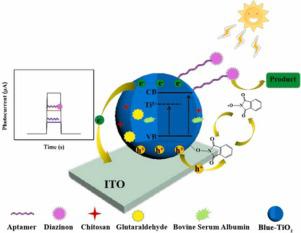Sensors and Actuators B: Chemical ( IF 8.0 ) Pub Date : 2022-05-24 , DOI: 10.1016/j.snb.2022.132101 Zuorui Wen , Lijun Ding , Weiran Zhu , Fuheng You , Tianshuo Wang , Nan Hao , Jie Wei , Kun Wang

|
Signal amplification strategies are of great interest in photoelectrochemical (PEC) sensing research. Herein, we explored a novel approach whereby hole transfer was accelerated from the photosensitive material Blue-TiO2 (B-TiO2) to the hole mediator N-hydroxyphthalimide (NHPI). Simultaneously, the introduction of the organic molecule NHPI can promote the efficiency of visible light absorption and expand the absorption range of B-TiO2. Under visible light irradiation, the photocurrent value of NHPI/B-TiO2 is 2.7-fold larger than that of B-TiO2, which can be ascribed to the acceleration of hole transfer by NHPI. More specifically, NHPI acts as a hole mediator, which effectively transfers photo-generated holes from the valence band (VB) of B-TiO2 to NHPI. NHPI can be oxidized to phthalimide-N-oxyl radical (PINO*), thereby causing inhibition of photo-generated carrier recombination and enhancement of the photocurrent. Furthermore, a PEC aptasensor for the sensitive detection of diazinon (DIA) was constructed by combining specific aptamers on an NHPI/B-TiO2 nanocomposite surface. The oxidation product of NHPI, PINO*, oxidizes the DIA captured by the aptamer. Under optimized experimental conditions, the linear range for DIA detection was 0.1–1000 nM, and the detection limit of the NHPI/B-TiO2 nanocomposite aptamer sensing was 0.03 nM (S/N = 3). Therefore, this proposed method involving the hole mediator can be used as a new strategy to improve the performance of PEC.
中文翻译:

使用 N-羟基邻苯二甲酰亚胺作为有效空穴介体的增强型光电化学适体传感对二嗪农农药的灵敏检测
信号放大策略在光电化学 (PEC) 传感研究中具有重要意义。在此,我们探索了一种新的方法,通过该方法可以加速从光敏材料 Blue-TiO 2 (B-TiO 2 ) 到空穴介质 N-羟基邻苯二甲酰亚胺 (NHPI) 的空穴转移。同时,有机分子NHPI的引入可以提高可见光吸收效率,扩大B-TiO 2的吸收范围。在可见光照射下,NHPI/B-TiO 2 的光电流值是B-TiO 2的2.7倍,这可以归因于 NHPI 对空穴传输的加速。更具体地说,NHPI充当空穴介体,其有效地将光生空穴从B-TiO 2的价带(VB)转移到NHPI。NHPI可被氧化为邻苯二甲酰亚胺-N-氧基自由基(PINO*),从而抑制光生载流子复合并增强光电流。此外,通过在 NHPI/B-TiO 2纳米复合材料表面上结合特定的适体,构建了一种用于灵敏检测二嗪农 (DIA) 的 PEC 适体传感器。NHPI 的氧化产物 PINO* 会氧化适配体捕获的 DIA。在优化的实验条件下,DIA检测的线性范围为0.1~1000 nM,NHPI/B-TiO 2的检测限为纳米复合适体传感为 0.03 nM (S/N = 3)。因此,这种涉及空穴介体的方法可以用作提高 PEC 性能的新策略。
















































 京公网安备 11010802027423号
京公网安备 11010802027423号